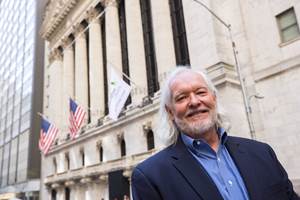SPI Bioplastics’ Inaugural Bioplastics Week
The first ever such event featured educational information, including infographics, reports and blog posts.
The first ever such event featured educational information, including infographics, reports and blog posts.
With the fanfare that this growing and evolving market deserves, SPI’s Bioplastics Division launched its first ever Bioplastics Week last week. Coordinated by assistant director of regulatory and technical affairs, Patrick Krieger, this digital campaign featured educational information about bioplastics.
As shown by recent studies, such as “Global Markets and Technologies for Bioplastics,” from BCC Research, the global market is projected to grow at a compound annual growth rate (CAGR) of 30% for the five-year period, 2015-2020.
According to SPI, the role of plastics in packaging, manufacturing, consumer goods, bottling and construction is growing thanks to the unique and unmistakable benefits they provide all participants in the value chain. Bioplastics are part of this plastics’ growth story that is helping brand owners and manufacturers find new applications and solutions.
A new report, an informative industry webinar, and a winner for the 2016 Innovation in Bioplastics Award were among the key highlights of this inaugural event.
• “Plastics Market Watch: Bioplastics,” report, which is based on the results of SPI’s nationwide survey on the topic, is designed to educate about the business and the environmental benefits of bioplastics products, and make the case for their increased use. SPI, which formed its Bioplastics Division in 2007, saw the need for such a report as noted by Krieger, “While growth continues in this sector of our industry, we recognize the challenges present in understanding the complex terminology and makeup of bioplastics products.”
As indicated by the 1,107 adults surveyed nationwide, there is little familiarity with or understanding about bioplastics, signaling a clear need to build more awareness. Only 27% of the respondents were somewhat or very familiar with bioplastics; 34% were not at all familiar; after learning about bioplastics, 50% of the respondents indicates they would consider purchasing a product it “was a little bit more expensive” because it was made with bioplastics; and, 57% indicated they would probably or definitely be more likely to consider purchasing a plastic product with the U.S. Department of Agriculture’s Certified Biobased Product seal.
• Bioplastics Week Webinar: SPI invited companies and individuals interested in learning more on how to make biodegradable or related environmental claims about their products or packaging. It included the following presentations:
“About SPI’s Bioplastics Division and Bioplastics Week,” presented by Keith Edwards from BASF;
“Avoiding FTC Pitfalls when Making Environmental Claims,” discussed by Sheila Millar from Keller and Heckman LLP;
“Industrial Compostability Claims Checklist,” by Edwin Tam from Teknor Apex.
• The 2016 Innovation in Bioplastics Award, which honors companies that apply bioplastics to innovative, purposeful product design, went to Club Coffee’s PurPod100. It offers consumers a single-serve coffee solution that breaks down fully in typical municipal and industrial composting facilities in as little as five weeks. Said company CEO John Pigott, “Our team and partners developed materials that are industrially compostable. Groundbreaking research produced materials, including a paper lid, a ring using chaff from coffee roasting and a mesh filter made of biobased plastic. Well-known coffee brands are now using PurPod100 to deliver a perfect cup of coffee for consumers who what a better approach to single-service convenience.”
Meanwhile, PurPod100 is the first product to earn certification by the Biodegradable Products Institute and its industrial composting abilities were confirmed by tests at composting sites in the U.S. and Canada. Research from the U.S. Composting Council supports PurPod100’s other environmental benefits such as reduced greenhouse gas emissions and the potential to divert tons of waste from landfills to industrial composting.
The growing phenomenon of single-serve coffee is apparent in office and home kitchens nationwide. According to Club Coffee, in 2014 almost 30% of U.S. consumers were drinking single-serve coffee, with U.S. single-serve retail coffee sales growth 319% between 2011 and 2015 to reach nearly $4.6 billion in revenue.

Related Content
Why Are They Blending Biopolymers?
A sit-down with bioplastic producer Danimer Scientific showed me there are more possible answers to that question than I had previously thought.
Read MoreBest Practices for Purging PHA and PHA/PLA Blends
Because bioplastics are processed at lower temperatures, purging between jobs requires a different process and purging agents than those applied for traditional resins.
Read MoreMaking a Play With PHA
Processors with sustainability goals or mandates have a number of ways to reach their goals. Biopolymers are among them.
Read MoreHow to Optimize Injection Molding of PHA and PHA/PLA Blends
Here are processing guidelines aimed at both getting the PHA resin into the process without degrading it, and reducing residence time at melt temperatures.
Read MoreRead Next
People 4.0 – How to Get Buy-In from Your Staff for Industry 4.0 Systems
Implementing a production monitoring system as the foundation of a ‘smart factory’ is about integrating people with new technology as much as it is about integrating machines and computers. Here are tips from a company that has gone through the process.
Read MoreMaking the Circular Economy a Reality
Driven by brand owner demands and new worldwide legislation, the entire supply chain is working toward the shift to circularity, with some evidence the circular economy has already begun.
Read MoreSee Recyclers Close the Loop on Trade Show Production Scrap at NPE2024
A collaboration between show organizer PLASTICS, recycler CPR and size reduction experts WEIMA and Conair recovered and recycled all production scrap at NPE2024.
Read More


























